Scioto Mile
The Scioto Mile is a collection of parks and trails in Columbus, Ohio. The parks along both banks of the Scioto River connect parts of the Scioto Greenway Trail with downtown Columbus and Franklinton. The nine parks total 145 acres (59 ha).[1]
| Scioto Mile | |
|---|---|
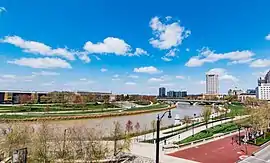 | |

Interactive map of the park network | |
| Administered by | Columbus Recreation and Parks Department |
| Public transit access | |
| Website | Official website |
History

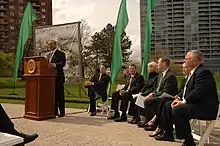
Around the beginning of the 20th century, the banks of the Scioto River were unremarkable, with housing and businesses lining it. Toward the beginning of the century, large civic buildings were planned and built: Columbus City Hall, the Ohio Judicial Center, and the Joseph P. Kinneary U.S. Courthouse. Bicentennial Park was the first added on the riverfront, in 1976. In 1983, Battelle Riverfront Park opened. The parks were separated, and Civic Center Drive, then a five-lane street, cut the parks off from downtown Columbus. A replica of Christopher Columbus's Santa María ship was docked at Battelle Riverfront Park beginning in 1992, intended to bring residents to the riverfront, with limited success. With Michael B. Coleman as mayor beginning in 2000, he spurred development of the riverfront. The Scioto Mile was planned to connect the two parks and bring residents to the riverfront.[2]
The Scioto Mile was developed from 2011 to 2015.[3] The first phase involved Civic Center Drive reduced from five to three lanes, allowing for installation of colonnades, fountains, gardens, and pavilions.[2] Next the park space along the entire Scioto River was redeveloped; Bicentennial Park was completely redesigned. The river was stagnant and muddy due to the Main Street Dam, a low head dam built in 1918 to control flooding, but which doubled the width of the river to 600 feet (180 m). The dam removal in 2013, along with sediment removal, narrowed the river to 300 feet (91 m), giving the city access to 33 acres (13 ha) of previously-submerged shoreline. The parks have helped revitalize the city's downtown area.[3]
From late 2018 to 2019, Smart Columbus operated a pilot program of electric driverless shuttles in a loop around the Scioto Mile. The program continued into 2020 in Columbus's Linden neighborhood.[4][5]
Attributes
The parks include Alexander AEP Park, Battelle Riverfront Park, Bicentennial Park, Dorrian Green, Genoa Park, McFerson Commons, North Bank Park, Scioto Audubon Metro Park, and the Scioto Mile Promenade. The parks are all city-owned, free and open to the public. All of the parks are open year-round, from at least 7 a.m. to 11 p.m.[1]
Events taking place throughout the Scioto Mile include the annual Columbus Arts Festival, the Columbus Caribbean Festival, Columbus Food Truck Festival, and its Earth Day celebrations.[6][7][8][9]
The river bank features a riparian zone, a natural line of plants along the river, keeping soil from eroding into the water.[10]
Gallery
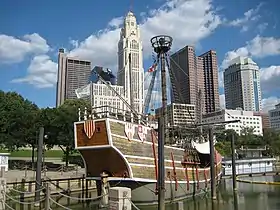 The Santa Maria Ship & Museum, a highlight of the riverfront for decades
The Santa Maria Ship & Museum, a highlight of the riverfront for decades The Promenade in 2010, in early stages of redevelopment
The Promenade in 2010, in early stages of redevelopment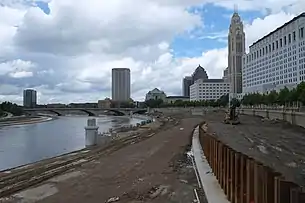 Creating park space in 2015
Creating park space in 2015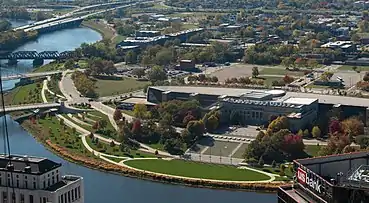 Genoa Park on the west bank
Genoa Park on the west bank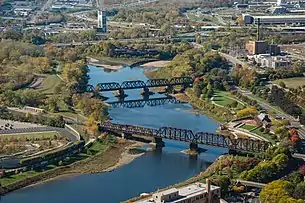 Battelle Riverfront and North Bank Parks on the east bank
Battelle Riverfront and North Bank Parks on the east bank
References
- "FAQ | Downtown Columbus Park Rules & Information". Scioto Mile. Retrieved 2020-04-07.
- "Scioto Mile: City banks on river in waterfront makeover". The Columbus Dispatch. July 7, 2011. Retrieved April 23, 2020.
- Schneider, Keith (May 31, 2016). "Open Spaces Bring Light to Downtown Columbus". The New York Times. Retrieved April 23, 2020.
- "The future is here, driverless shuttles now cruising Scioto Mile". 614now. 2018-12-11. Retrieved 2020-04-07.
- "Scioto Mile self-driving shuttle shutting down, focus shifts to Linden". www.bizjournals.com. 2019-09-03. Retrieved 2020-04-07.
- "Columbus Arts Festival canceled". The Lantern. April 3, 2020.
- JR, GARY SEMAN. "Columbus' April 25 Earth Day celebration canceled because of coronavirus". ThisWeek Community News.
- "Columbus Caribbean Festival returns to Scioto Mile". The Lantern. September 12, 2019.
- "2019 Columbus Food Truck Festival coming to Scioto Mile". July 29, 2019.
- "Central Ohio Parks: The Scioto Greenways transforms Downtown Columbus". Columbus Monthly. June 29, 2016. Retrieved April 23, 2020.